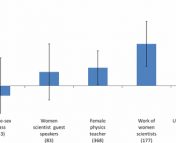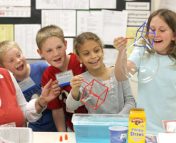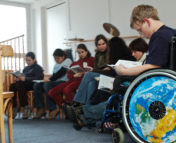Title: Identifying the stereotypical who, what, and why of physics and biology
Authors: Megan Bruun, Shannon Willoughby, Jessi L. Smith
First author institution: Montana State University
Journal: Physical Review Physics Education Research (Open Access)
A Problem of Equity
For fifty years, social scientists have been trying the classic experiment of asking children to draw a scientist. Only 28 of the drawings depicted female scientists in the original 1970s experiment, out of almost 5,000 trials. Although female representation in both the drawing experiment and real life science has improved since then, the pervasive stereotype remains, with kids still drawing almost twice as many male scientists as female ones. Current events reinforce the notion that gendered stereotypes and sexism, both outright and implicit, are alive and well within science, from a physicist at CERN making (public) sexist remarks to NASA’s recent cancellation of the first all-female spacewalk to the notorious lack of female physics Nobel laureates.
Among the sciences, physics is notorious for its lagging representation of women and other marginalized groups. According to a 2014 study by the National Science Foundation, “nearly 60% of physics faculty in the U.S. were white men. In contrast, only 45% of biology faculty in the U.S. during that same time frame were white men.” Although there are many complex (and often intertwined) factors that influence this statistic, one notable facet is the “old white man” stereotype prevalent in physics. As defined in today’s paper, stereotypes “are overgeneralized thoughts about a group…that provide easily accessible, perhaps even inescapable, information that influences how people think and behave.” What people think about physics and physicists affects who decides to join our workforce and community, often hindering the broad, diverse participation in science that many people are trying to improve, such as through Inclusive Astronomy. Effects such as stereotype threat also affect performance in many standard metrics of achievement, such as standardized tests. Understanding how the field of physics is perceived and what stereotypes it carries is one of the first steps in breaking down the barriers to entry into this field.
Studying Stereotypes
Many social science studies have investigated what stereotypes are held about scientists in general, but nothing in the research literature specifically distinguishes stereotypes about physics. This new study in stereotypes, led by a collaboration of both physicists and psychologists, sets out to use the tools of social science to understand and delineate people’s judgments of physics, in contrast with their thoughts about biology. The goal is to eventually use their new information about physics stereotypes to help inform educators’ efforts in breaking down these views and encouraging broader participation in the field.
Participants in this study were randomly assigned to give quick judgments on either physics or biology, and to rate certain traits of the scientist (e.g. intelligence, attractiveness, competence) and characteristics of the field (e.g. requires natural talent, stressful, masculine, feminine) on a scale of 1 to 5. They were also asked to rate their emotions about the field, including pity, envy, admiration, and contempt.
The sample of perspectives in this study includes both the general public and scientists, from various geographic locations (across the U.S.) and different career stages. With nearly identical results across the sample, the responses showed negative perceptions of science as a whole, with physicists perceived more negatively than biologists. So, what makes a stereotypical physicist then? Compared to biologists, physicists are ranked as more competent, tech-oriented, and awkward, but less attractive and social. Physics is regarded as a field where there are less opportunities to work with and help people, but there are more opportunities for individual agency. It is thought of as a difficult and often-envied field, which requires both a larger effort to succeed and some innate brilliance. Physics is also stereotyped as more masculine than biology. Results are summarized in visual format in Figures 1-3. These stereotypes are likely unsurprising, given the pervasive reinforcement of them in culture and entertainment.
Breaking the Stereotypes, Changing the Culture
Given the negative and exclusionary perceptions of physics, what changes can we make so that the stereotypes accurately reflect the state of the field and the scientists within it? This paper gives some recommendations for breaking down the stereotypes they described:
- Establish a growth mindset – To counteract the idea that physics requires innate brilliance or natural talent, educators and students should incorporate the well-documented idea of a cultivating a growth mindset – the idea that effort is valued, and even the very difficult tasks are possible with hard work.
- Increase exposure to role models – This can help break down many facets of the stereotype, by showing scientists as real people with varied interests, skills, personalities, and backgrounds, who collaborate with each other. Note – there are some great programs that exist to help solve this problem, such as Skype a Scientist!
- Foster a sense of belonging – The authors suggest incorporating classroom activities that help break down the “geeky” stereotypes and help make students feel like they belong. Some examples are writing a letter to a hypothetical future physics student and other brief “values affirmation” writing tasks.
- Participate in CUWiP – For undergraduate physics programs, departments are encouraged to participate in the Conference for Undergraduate Women in Physics that take place every year.
- Know where you start – Broadly, teachers need to acknowledge that when students come into their science classroom, they are likely entering with some preconceived notion and stereotype of who can succeed in that field. Awareness of this can help teachers proactively combat stereotypes and their detrimental effects on the students and the learning environment.
From elementary school classrooms to scientific conferences, breaking down stereotypes at all levels will help bring perceptions of physics in line with the real life scientists who are a part of it. These recommendations – and more importantly, the awareness and knowledge of the stereotypes we’re working against – are a part of making concrete changes to create a future in physics and astronomy that is founded on principles of equity and inclusion.
(Header photo, courtesy of https://www.theatlantic.com/science/archive/2018/03/what-we-learn-from-50-years-of-asking-children-to-draw-scientists/556025/)




